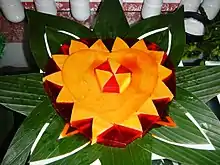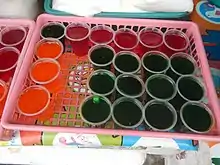Gulaman
Gulaman, in Filipino cuisine, is a bar of or powdered form of dried agar used to make jelly-like desserts. In common usage, it also usually refers to the refreshment sago't gulaman, sometimes referred to as samalamig, sold at roadside stalls and vendors.
 A dessert made from leche flan and gulaman from Baliuag, Bulacan | |
| Course | Dessert |
|---|---|
| Place of origin | Philippines |
| Serving temperature | Cold |
| Main ingredients | Agar |
Description

Gulaman is the Filipino culinary use of agar, which is made of processed seaweed, mostly from Gelidium corneum—one of the most common edible algae.[1] It is usually sold dehydrated and formed into foot-long dry bars which are either plain or coloured.[2] It is also commonly sold in powder form.[3]
Uses
Gulaman bars are used in the various Filipino refreshments or desserts such as sago at gulaman, buko pandan, agar flan, halo-halo, different varieties of Filipino fruit salads, black gulaman, and red gulaman.
Differences between gelatine and gulaman
The term gelatine (or "jelly") and gulaman are used synonymously in the Philippines, although they are very different products. While gelatine is a protein, gulaman is a plant-derived carbohydrate,[4] made from seaweed. This distinction makes gulaman suitable for those who may not eat gelatine for religious or cultural reasons, such as Muslims.
Gelatine dissolves in hot water but boiling water is necessary to dissolve gulaman. Unlike gelatine which sets at refrigerator temperature, gulaman sets at room temperature. While gelatine can melt at room temperature, it is uniquely thermo-reversible[4] to its previous shape and form.
References
- "Gulaman". Philippine Medicinal Plants. Retrieved 2008-07-07.
- "Gulaman at Sago (Agar-Agar and Tapioca Pearls)". Lafang: a Pinoy food blog. 2006-07-13. Archived from the original on 2008-06-18. Retrieved 2008-07-07.
- "ZANG Gulaman". shireli.
- "Things you need to know about gelatine". Food Magazine-Philippines: 99. December 2006 – January 2007.
